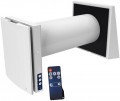Heat exchanger efficiency
Efficiency of the heat exchanger used in the heat exchanger of the supply and exhaust system (see "Features").
Efficiency is defined as the ratio of useful work to the energy expended. In this case, this parameter indicates how much heat taken from the exhaust air, the heat exchanger transfers to the supply air. The efficiency is calculated by the ratio between the temperature differences: you need to determine the difference between the outdoor air and the supply air after the heat exchanger, the difference between the outdoor and exhaust air, and divide the first number by the second. For example, if at an outside temperature of 0 °С, the temperature in the room is 25 °С, and the heat exchanger produces air with a temperature of 20 °С, then the efficiency of the heat exchanger will be (25 – 0)/(20 – 0)= 25/20 = 80%. Accordingly, knowing the efficiency, it is possible to estimate the temperature at the outlet of the heat exchanger: the temperature difference between the inside and outside must be multiplied by the efficiency and then the resulting number is added to the outside temperature. For example, for the same 80% at an outdoor temperature of -10 °C and an internal temperature of 20 °C, the inflow temperature after the heat exchanger will be (20 – -10)*0.8 + -10 = 30*0.8– 10 = 24 – 10 = 14 °C.
The higher the efficiency, the more heat will be returned to the room and the more savings on heating will be. At the same time, a highly efficient heat e...xchanger is usually expensive. Also note that the efficiency may vary slightly for certain values of the external and internal temperatures, while manufacturers tend to indicate the maximum value of this parameter — accordingly, in fact, it may turn out to be lower than the claimed one.
Control via Internet
Ability
to control device via the Internet. The connection of the unit to the World Wide Web, usually, is carried out via Wi-Fi, and the control format may be different: in some models, you need to use a special application installed on your smartphone or tablet; in others, it is enough to open a special page in a browser. Anyway, this function allows you to control the device from anywhere in the world where there is Internet access, as well as, monitor its status and receive notifications about various operating parameters (current power, outdoor temperature, failures and malfunctions, etc.).
Power consumption in ventilation mode
The electrical power consumed by the supply and exhaust unit in normal operating mode (for models with adjustable performance — at maximum speed) can help determine the connection requirements for the unit and estimate the cost of operation in terms of electricity bills. It should be noted that for models with an electric reheater (see "Reheater type"), this refers only to the power of the ventilation system, while the power of the reheater is provided separately (see above). Therefore, the total energy consumption during full operation will correspond to the sum of these power values.
The power consumption can also be used to some extent to assess the unit's performance: "power-hungry" units usually provide a corresponding airflow.
Minimum wall thickness
The minimum wall thickness on which the air ventilation unit can be hung with the possibility of wall mounting.
This parameter is indicated for models mounted directly into a hole in the wall — see "Mounting" for details. The installation length (the length of the pipe between the trims) can usually be adjusted to suit specific wall thicknesses. However, if this thickness is too small, then even an extremely shortened pipe will stick out of it, preventing the entire structure from being securely fixed. This is the reason for this limitation. Theoretically, the situation can be corrected — for example, by building up a wall at the installation site — however, in fact, such options are unlikely to be considered seriously. Nevertheless, in most models, this limitation does not exceed 300 mm, and it is very rarely necessary to install ventilation units on thinner walls.

